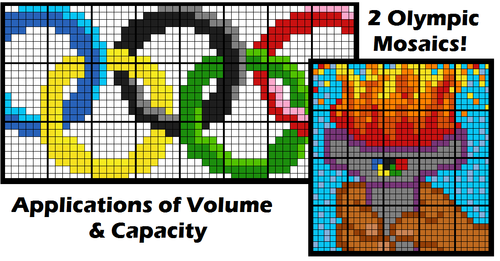







Highly engaging! 2 Olympic Mosaics Included! Each student's worksheet is different, ensuring individual accountability. Each worksheet represents a small section of the big picture, providing collaborative motivation! Engage your class in an Olympic mosaic involving real-life volume application problems (word problems).
Worksheets integrate metric and imperial units, and use decimal and fractional length values (randomly 20% of the time). Units are chosen randomly for each problem, providing an opportunity for students to decide if the measurement is realistic or not, building a strong conceptual understanding of cubic units of measurement.
INCLUDED:
-.pdf and .docx of everything
-Class set of the Olympic Rings mosaic (24-sheet set)
-Class set of the Olympic Torch mosaic (20-sheet set)
-A Teaching Tips page for each
-An answer-range key for quick student assessment at a glance. (i.e. "Blue always has an answer between 120 and 160")
-A COMPLETE ANSWER KEY for every worksheet!
-A coloured, coordinate-labelled image of each mosaic to help you assemble the completed pictures.
-The "Problem Order" list (shown above), giving the order of problem types on the worksheets.
THE MATH INVOLVED:
-Interpret V word problems arising from real life contexts
-Use volume formulas for cylinders, prisms, pyramids, cones, and spheres to solve problems
-Work with fractional and decimal edge lengths in the context of solving real-world problems
-Use both metric and imperial units of measurement for length and volume, and consider the appropriateness of the (randomly chosen) unit for each problem.
-Use the Pythagorean theorem to solve for necessary dimensions (slant height, perpendicular height, apex height)
-Determine desired dimensions given information about the shape (i.e. get radius from circumference)
All my "Colouring by..." math mosaics use the standard colours found in a Crayola 24 pack of coloured pencils. For best results, use the exact colour name match, and stick to one type of colouring medium. Maybe a class set of pencil crayons would be a fun departmental purchase? :)
I'd love to hear from you! (calfordmath@live.ca.)
Worksheets integrate metric and imperial units, and use decimal and fractional length values (randomly 20% of the time). Units are chosen randomly for each problem, providing an opportunity for students to decide if the measurement is realistic or not, building a strong conceptual understanding of cubic units of measurement.
INCLUDED:
-.pdf and .docx of everything
-Class set of the Olympic Rings mosaic (24-sheet set)
-Class set of the Olympic Torch mosaic (20-sheet set)
-A Teaching Tips page for each
-An answer-range key for quick student assessment at a glance. (i.e. "Blue always has an answer between 120 and 160")
-A COMPLETE ANSWER KEY for every worksheet!
-A coloured, coordinate-labelled image of each mosaic to help you assemble the completed pictures.
-The "Problem Order" list (shown above), giving the order of problem types on the worksheets.
THE MATH INVOLVED:
-Interpret V word problems arising from real life contexts
-Use volume formulas for cylinders, prisms, pyramids, cones, and spheres to solve problems
-Work with fractional and decimal edge lengths in the context of solving real-world problems
-Use both metric and imperial units of measurement for length and volume, and consider the appropriateness of the (randomly chosen) unit for each problem.
-Use the Pythagorean theorem to solve for necessary dimensions (slant height, perpendicular height, apex height)
-Determine desired dimensions given information about the shape (i.e. get radius from circumference)
All my "Colouring by..." math mosaics use the standard colours found in a Crayola 24 pack of coloured pencils. For best results, use the exact colour name match, and stick to one type of colouring medium. Maybe a class set of pencil crayons would be a fun departmental purchase? :)
I'd love to hear from you! (calfordmath@live.ca.)
Something went wrong, please try again later.
This resource hasn't been reviewed yet
To ensure quality for our reviews, only customers who have purchased this resource can review it
Report this resourceto let us know if it violates our terms and conditions.
Our customer service team will review your report and will be in touch.
$5.00
